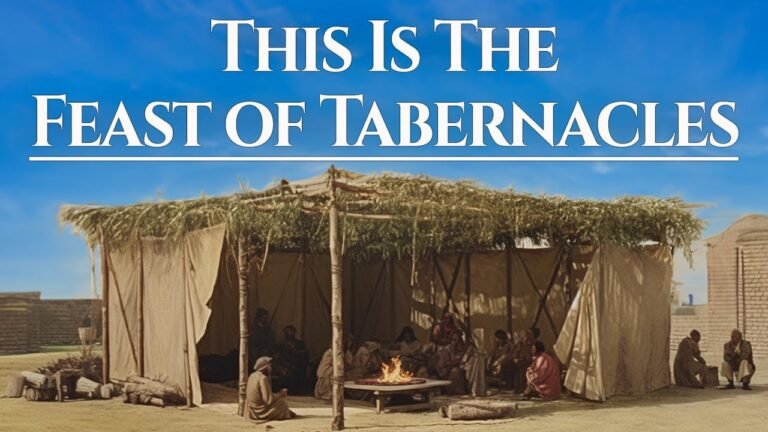Understanding the Timing of the Feast of Tabernacles
The Feast of Tabernacles, also known as Sukkot, is a significant biblical festival celebrated by Jewish communities around the world. Observed five days after Yom Kippur, this vibrant holiday often falls in late September or early October, marking the harvest season and commemorating the Israelites’ journey through the wilderness. As families gather in temporary shelters, they reflect on themes of gratitude, hospitality, and divine protection. Understanding when the Feast of Tabernacles occurs not only enriches one’s knowledge of Jewish traditions but also highlights the festival’s enduring relevance in today’s multicultural society.
What is the significance of the Feast of Tabernacles?
The Feast of Tabernacles, also known as Sukkot, holds profound significance in Jewish tradition as a time of gathering and reflection. This annual pilgrimage festival invites Jewish communities to come together in Jerusalem, fostering a sense of unity and shared heritage. It serves as a poignant reminder of the Israelites’ journey through the Wilderness, highlighting God’s unwavering provision and protection during their time of need.
As participants dwell in temporary shelters, or sukkahs, they reconnect with their history and the lessons learned from their ancestors. The act of living in these makeshift structures symbolizes the fragility of life and the importance of faith in divine sustenance. It is a time for gratitude, as families and communities express their appreciation for the harvest and the blessings bestowed upon them throughout the year.
Looking beyond the present, the Feast of Tabernacles also embodies a hopeful anticipation for the future. It signifies the expectation of the Messianic age, when all nations will unite in Jerusalem to worship the Lord. This vision of global harmony and spiritual fulfillment inspires participants to embrace their faith and share their traditions, fostering a sense of hope that transcends generations.
Do Christians celebrate the Feast of Tabernacles?
The Feast of Tabernacles, also known as Sukkot, holds significant meaning for many Christians today. This festival is not only a time of celebration and joy but also an opportunity for believers to reflect on their spiritual journey and strengthen their relationship with God. It serves as a reminder of God’s provision and faithfulness throughout history, inviting participants to embrace a deeper connection with their faith.
During this festive season, Christians often engage in various activities that symbolize gratitude and community. Whether through communal gatherings, prayer, or acts of service, the Feast of Tabernacles fosters a spirit of unity and appreciation for the blessings in their lives. Ultimately, this observance enriches their spiritual walk, encouraging a renewed commitment to living out their faith in meaningful ways.
What is the current name for the Feast of Tabernacles?
Sukkot, commonly referred to as the Feast of Tabernacles, is a vibrant Jewish holiday celebrated on the fifteenth day of Tishrei, the seventh month of the Jewish calendar. This festive occasion, also known as the Feast of Booths or the Feast of Ingathering, involves building temporary structures called sukkahs, reflecting the Israelites’ journey through the wilderness.
The holiday is a time of joy and gratitude, marking the harvest season while commemorating the Israelites’ reliance on God during their forty years in the desert. Sukkot invites families and communities to come together, share meals in the open air, and engage in festive rituals, reinforcing the bonds of tradition and faith while celebrating the abundance of life.
Exploring the Significance of the Feast’s Timing
The timing of the Feast plays a importante role in its significance, intertwining cultural, historical, and spiritual dimensions. Celebrated at a pivotal moment in the agricultural calendar, the Feast not only marks the end of a fruitful harvest but also serves as a reminder of the cycles of nature and the importance of gratitude. This seasonal alignment fosters a sense of community, as families and friends come together to honor their shared experiences and the bounty of the land.
Moreover, the Feast’s timing often coincides with significant religious observances, enhancing its meaning for many participants. It provides an opportunity for reflection and renewal, inviting individuals to pause amidst the hustle of daily life and reconnect with their values and traditions. This duality of celebration—both earthly and spiritual—underscores the Feast’s enduring relevance, making it a cherished occasion that resonates across generations and cultures.
Unveiling the Historical Context of the Feast
The Feast has deep roots in cultural traditions, tracing back centuries to rituals that celebrated the changing seasons and agricultural bounty. Historically, it served as a communal gathering, allowing people to come together in gratitude for the harvest. As societies evolved, these gatherings transformed into elaborate festivities, blending age-old customs with contemporary practices. This evolution reflects not only the passage of time but also the resilience of community bonds that thrive on shared experiences and mutual appreciation.
In modern times, the Feast has become a vibrant tapestry of flavors, stories, and connections. It showcases regional cuisines that honor ancestral recipes while inviting innovation and creativity. This celebration is not merely about the food; it embodies a spirit of unity, where families and friends forge stronger ties through shared meals and traditions. By understanding its historical context, we can fully appreciate the significance of the Feast as a timeless tribute to both our heritage and our collective future.
The Spiritual Lessons of Seasonal Celebrations
Seasonal celebrations have long served as profound reminders of the cyclical nature of life, offering us spiritual lessons that resonate deeply within our souls. Each season brings a unique opportunity for reflection, growth, and connection to the world around us. As we transition from the vibrant rebirth of spring to the introspective stillness of winter, we are invited to embrace the wisdom inherent in these changes, recognizing that every ending paves the way for a new beginning.
In the warmth of summer, we celebrate abundance and joy, encouraging us to cultivate gratitude for the blessings in our lives. This season teaches us the importance of community and connection, reminding us that we are all part of a greater whole. Similarly, autumn’s transformation serves as a powerful metaphor for letting go, encouraging us to release what no longer serves us and to honor the beauty in impermanence. These seasonal shifts awaken our awareness of the natural cycles, prompting us to align our lives with the rhythms of nature.
As we engage in seasonal festivities, we are not merely participating in time-honored traditions; we are also deepening our spiritual understanding and connection to ourselves and others. Each celebration invites us to pause, reflect, and engage in practices that nourish our spirit, fostering a sense of belonging and purpose. By embracing the lessons of each season, we can cultivate resilience, gratitude, and a profound appreciation for the journey of life, ultimately leading us to a more harmonious existence.
Navigating the Calendar: When to Observe the Feast
The Feast is a cherished occasion that invites communities to come together in celebration, reflection, and gratitude. Typically observed on a specific date each year, understanding the nuances of its timing can enhance the experience. Factors such as local traditions, lunar cycles, and cultural significance play a importante role in determining the best time to partake in the festivities. By aligning with these elements, participants can truly immerse themselves in the spirit of the Feast.
As the date approaches, preparation becomes key to a meaningful observance. Organizing gatherings, sharing stories, and preparing traditional foods are ways to honor this special time. Communities often engage in activities that foster connection and understanding, creating a sense of unity among participants. Whether it’s through prayer, music, or communal meals, each element contributes to a richer celebration, ensuring that the essence of the Feast resonates deeply within the hearts of all who join.
The Feast of Tabernacles, celebrated in the fall, invites communities to reflect on themes of gratitude, unity, and the beauty of the harvest season. As families gather to share meals, stories, and traditions, this joyous occasion serves as a reminder of the importance of faith and fellowship in our lives. Mark your calendars and embrace the spirit of this cherished holiday, ensuring that its significance resonates in your heart and home.






